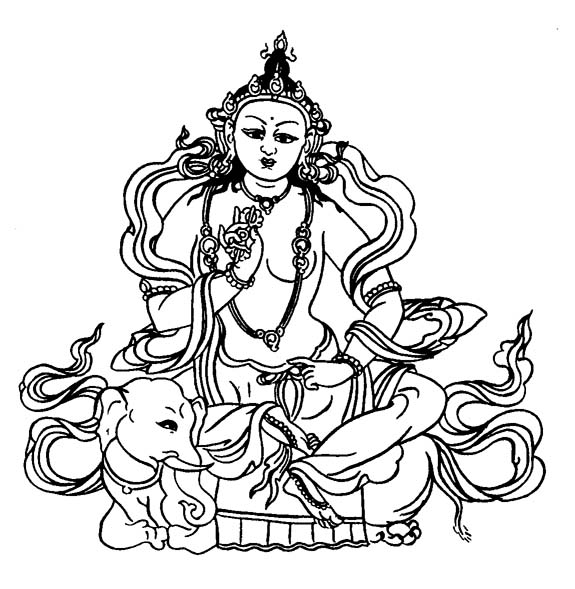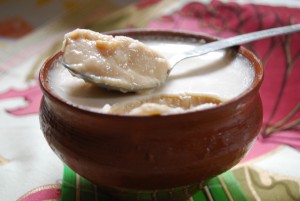1. Sati - One who got burned alive
2. Saadhvi -The Sanguine
3. Bhavaprita - One who is loved by the universe
4. Bhavaani - The abode of the universe
5. Bhavamochani - The absolver of the universe
6. Aarya - Goddess
7. Durga - The Invincible
8. Jaya - The Victorious
9. Aadya - The Initial reality
10. Trinetra - One who has three-eyes
11. Shooldharini - One who holds a monodent
12. Pinaakadharini - One who holds the trident of Shiva
13. Chitra - The Picturesque
14. Chandaghanta - One who has mighty bells
15. Mahaatapa - With severe penance
16. Manah - Mind
17. Buddhi - Intelligence
18. Ahankaara - One with Pride
19. Chittarupa - One who is in thought-state
20. Chita - Death-bed
21. Chiti - The thinking mind
22. Sarvamantramayi - One who possess all the instruments of thought
23. Satta - One who is above all
24. Satyanandasvarupini - Form of Eternal bliss
25. Ananta - One who is Infinite or beyond measure
26. Bhaavini - The Beautiful Woman
27. Bhaavya - Represents Future
28. Bhavya - With Magnificence
29. Abhavya - Improper or fear-causing
30. Sadagati - Always in motion, bestowing Moksha (salvation)
31. Shaambhavi - Consort of Shambhu
32. Devamata - Mother Goddess
33. Chinta - Tension
34. Ratnapriya - Adorned or loved by jewels
35. Sarvavidya - Knowledgeable
36. Dakshakanya - Daughter of Daksha
37. Dakshayajñavinaashini - Destroyer of the sacrifice of Daksha
38. Aparna - One who doesn’t eat even leaves while fasting
39. Anekavarna - One who has many complexions
40. Paatala - Red in color
41. Paatalavati - Wearing red-color attire
42. Pattaambaraparidhaana - Wearing a dress made of leather
43. Kalamanjiiraranjini - Wearing a musical anklet
44. Ameyaa - One who is beyond measure
45. Vikrama - Violent
46. Krrooraa - Brutal (on demons)
47. Sundari - The Gorgeous
48. Sursundari - Extremely Beautiful
49. Vandurga - Goddess of forests
50. Maatangi - Goddess of Matanga
51. Matangamunipujita - Worshipped by Sage Matanga
52. Braahmi - Power of God Brahma
53. Maaheshvari - Power of Lord Mahesha (Shiva)
54. Aeindri - Power of God Indra
55. Kaumaari - The adolescent
56. Vaishnavi - The invincible
57. Chaamunda - Slayer of Chanda and Munda(demons)
58. Vaarahi - One who rides on Varaah
59. Lakshmi - Goddess of Wealth
60. Purushaakriti -One who takes the form of a man
61. Vimalauttkarshini -One who provides joy
62. Gyaana - Full of Knowledge
63. Kriya - One who is in action
64. Nitya - The eternal one
65. Buddhida - The bestower of wisdom
66. Bahula - One who is in various forms
67. Bahulaprema - One who is loved by all
68. Sarvavahanavahana -One who rides all vehicles
69. NishumbhaShumbhaHanani - Slayer of the demon-brothers Shumbha Nishumbha
70. MahishasuraMardini - Slayer of the bull-demon Mahishaasura
71. MadhuKaitabhaHantri - Slayer of the demon-duo Madhu and Kaitabha
72. ChandaMundaVinashini - Destroyer of the ferocious asuras Chanda and Munda
73. Sarvasuravinasha - Destroyer of all demons
74. Sarvadaanavaghaatini - Possessing the power to kill all the demons
75. Sarvashaastramayi - One who is deft in all theories
76. Satya - The truth
77. Sarvaastradhaarini - Possessor of all the missile weapons
78. Anekashastrahasta - Possessor of many hand weapons
79. AnekastraDhaarini - Possessor of many missile weapons
80. Komaari - The beautiful adolescent
81. Ekakanya - The girl child
82. Kaishori - The adolescent
83. Yuvati - The Woman
84. Yati - Ascetic, one who renounces the world
85. Apraudha - One who never gets old
86. Praudha - One who is old
87. Vriddhamaata - The old mother (loosely)
88. Balaprada - The bestower of strength
89. Mahodari - One who has huge belly which stores the universe
90. Muktakesha - One who has open tresses
91. Ghorarupa - Having a fierce outlook
92. Mahaabala - Having immense strength
93. Agnijwaala - One who is poignant like fire
94. Raudramukhi - One who has a fierce face like destroyer Rudra
95. Kaalaratri - Goddess who is black like night
96. Tapasvini - one who is engaged in penance
97. Narayani - The destructive aspect of Lord Narayana (Brahma)
98. Bhadrakaali Fierce form of Kali
99. Vishnumaya Spell of Lord Vishnu
100. Jalodari - Abode of the ethereal universe
101. Shivadooti - Ambassador of Lord Shiva
102. Karaali - The Violent
103. Ananta - The Infinite
104. Parameshvari - The Ultimate Goddess
105. Katyayani -One who is worshipped by sage Katyanan
106. Savitri - Daughter of the Sun God Savitr
107. Pratyaksha - One who is real
108.
Brahmavaadini One who is present everywhere























